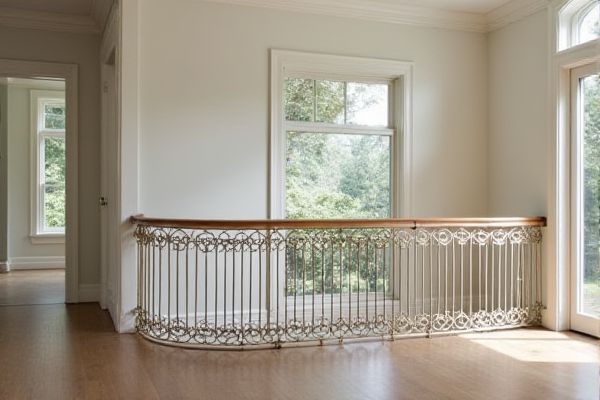
Openwork railing offers a visually lighter, more decorative design that enhances outdoor views and allows airflow, while solid panel railing provides greater privacy, noise reduction, and a more modern, sleek appearance. Explore the rest of the article to determine which railing style best suits Your aesthetic preferences and functional needs.
Table of Comparison
| Feature | Openwork Railing | Solid Panel Railing |
|---|---|---|
| Design | Decorative, intricate patterns, visually light | Simple, clean lines, visually heavy |
| Visibility | Allows clear sightlines and airflow | Blocks view, provides privacy |
| Privacy | Low privacy, open structure | High privacy, solid barrier |
| Wind Resistance | Allows wind to pass through easily | Blocks wind, can create resistance |
| Maintenance | Requires cleaning of intricate details | Easy to clean flat surfaces |
| Material Options | Metal, wrought iron, wood | Glass, metal panels, wood |
| Safety | Good visibility, but gaps present | Complete barrier, safer for children/pets |
| Cost | Generally moderate, depends on detail | Varies; glass panels can increase cost |
| Applications | Balconies, staircases, decorative decks | Privacy fences, pool surrounds, modern decks |
Introduction to Railing Types
Openwork railing features spaced balusters or decorative patterns that enhance visibility and airflow, creating a lighter, more open aesthetic. Solid panel railing consists of continuous materials such as glass, wood, or metal panels, providing greater privacy, wind protection, and a modern, streamlined appearance. Your choice depends on whether you prioritize openness and visibility or privacy and solidity in your railing design.
What is Openwork Railing?
Openwork railing features a design with spaces or gaps between the rails, allowing light and air to pass through while offering a decorative, airy look. This type of railing is often made from materials such as metal or wood, providing both safety and aesthetic appeal with intricate patterns or simple vertical bars. Your choice of openwork railing can enhance outdoor views and create a sense of openness compared to solid panel railing.
What is Solid Panel Railing?
Solid panel railing consists of continuous, flat surfaces made from materials like glass, metal, or wood, offering enhanced privacy and wind protection compared to openwork railing. This type of railing provides a sleek, modern appearance while improving safety by preventing objects from passing through gaps common in openwork designs. Solid panel railings are ideal for environments requiring noise reduction, unobstructed views, and durability against weather elements.
Aesthetic Differences
Openwork railing features intricate patterns and transparent designs that create a visually light and airy aesthetic, enhancing the visibility of your outdoor space. Solid panel railing offers a sleek, modern look with uninterrupted surfaces that provide privacy and a bold statement. Your choice between openwork and solid panel railing impacts the overall style and openness of your deck or balcony environment.
Privacy Considerations
Openwork railings offer less privacy due to their gaps, allowing visibility through the design, which can be a concern for homeowners seeking seclusion. Solid panel railings provide maximum privacy by creating a continuous barrier that blocks sightlines completely, ideal for patios and balconies. Choosing between these options depends on balancing aesthetic preferences with the need for privacy and openness in outdoor spaces.
Durability and Maintenance
Openwork railing offers superior airflow and visibility but may require more frequent cleaning to prevent dirt buildup in the intricate designs, while solid panel railing provides enhanced durability by resisting dents and weather damage due to its continuous surface. Materials like aluminum or steel used in openwork railings are often treated with rust-resistant coatings, but solid panels made from composite or tempered glass require less routine maintenance to retain their appearance and structural integrity. Choosing between the two depends on your preference for ease of upkeep versus aesthetic appeal and long-term weather resistance.
Safety and Security
Openwork railings, featuring gaps and intricate designs, provide visibility and airflow but may pose safety risks for children or pets due to potential climbing hazards and larger openings. Solid panel railings offer enhanced safety by minimizing gaps, preventing falls, and improving security by acting as a barrier against intruders or debris. Both types must comply with local building codes, which often set specific height and spacing requirements to ensure optimal safety and security.
Cost Comparison
Openwork railing typically costs less than solid panel railing due to lower material usage and simpler installation requirements. Solid panel railings often use more durable and heavier materials, increasing both material and labor expenses. Your choice impacts overall budget, with openwork offering affordability and solid panels providing enhanced privacy at a higher cost.
Popular Applications
Openwork railing is popular for decks, patios, and balconies where visibility and airflow are desired, enhancing aesthetic appeal and outdoor experience. Solid panel railing is preferred for pool areas, staircases, and privacy fencing, providing safety, wind protection, and noise reduction. Your choice depends on whether visibility or privacy is the priority for your outdoor space.
Choosing the Right Railing for Your Space
Openwork railings offer a visually lighter design with better airflow and visibility, making them ideal for spaces where openness and aesthetics are priorities. Solid panel railings provide enhanced privacy and wind protection, perfect for areas requiring safety and seclusion. Evaluating your space's needs for visibility, privacy, and maintenance will help you determine whether openwork or solid panel railings best suit your outdoor environment.
 homyna.com
homyna.com